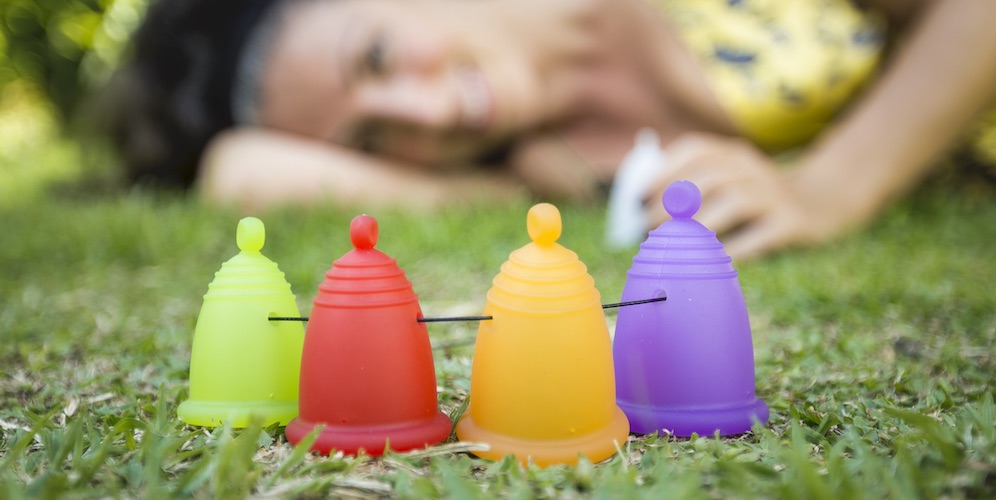Not only is PMS one of the worst parts about getting your period, but it’s also one of the most unexplained and explored parts of menstruation.

Considering the majority of women will experience PMS at some point in their lives — and most likely suffer from it multiple times — we know shockingly little about PMS.
It’s more referred to jokingly, or as an arbitrary concept, rather than an actual syndrome. Combined with the attached stigma, it’s not surprising that PMS is misunderstood and not treated properly — by ourselves, our partners, and medical professionals.
What exactly is PMS?
PMS stands for premenstrual syndrome: the name given to a collection of different physical and psychological symptoms that women experience in the last half of their cycle — just before menstruation begins each month (and just after ovulation).
These symptoms usually start around a week before your period and tend to go away within the first few days of your period starting — although they may appear two weeks before your period, and last for as long as five days into your period. This means that PMS could last for as much as half of your cycle each month. Generally, however, it tends to last around a week, but it could be over in just a couple of days.
Many women experience PMS differently
There are thought to be over 150 symptoms of PMS. This is a huge amount of symptoms — both physical and psychological — which means that many women experience PMS differently, so it’s not totally surprising that we often struggle to recognize and diagnose PMS in ourselves.
The most common physical symptoms of PMS
- Cramping
- Bloating
- Breast tenderness
- Hot flushes
- Changes in appetite or food cravings
- Acne
- Clumsiness
- Fatigue or sleepiness
- Problems sleeping
Some of the most common psychological (emotional and mental) symptoms include:
- Mood swings
- Irritability
- Anxiety
- Depression or low mood
- Trouble concentrating
- A decrease in sex drive
Of course, these are just some of the main symptoms, but there are many that you could experience, ranging from constipation to increased sensitivity to light and sound.
If you’re unsure whether what you’re experiencing is PMS or something else, you can always keep a note of how you feel leading up to when your period starts; by jotting down your symptoms and feelings, you’ll be able to recognize a pattern which will help you establish if it is PMS and how to treat it.
PMS can be a totally normal part of your monthly cycle, but if you find it is affecting your day-to-day life or health, then you should speak to your doctor to try and find a solution together.
PMS is very, very common
It’s not exactly known how many people suffer from PMS because it is so frequently mistaken for the normal emotional and physical changes that happen just before your period starts.
However, it is thought that as many as three in four women experience PMS at some point in their lives. A smaller percentage of these (around 20-30%) suffer from severe PMS: psychological symptoms that can be so extreme that the women who experience them cannot continue with their lives as normal.
PMS can be mistaken for other disorders with similar symptoms
There are a handful of other conditions and disorders that PMS can be mistaken for (or vice versa). This is because they share the same — or at least very similar — symptoms. Below we’ve listed the main conditions that are often confused with PMS:
The menopause
The menopause is a completely natural part of life that happens to every woman at some point in their life. Women tend to go through menopause in their early fifties, but some women may experience it earlier than others. This can be as early as your mid-thirties, in which case it is known as premature menopause.
There are many symptoms of the menopause that are similar to PMS — namely mood swings, hot flushes and a decrease in your sex drive.
You don’t have to suffer through the symptoms of menopause — many women choose HRT (hormone replacement therapy) to relieve menopause symptoms and make the whole experience much, much easier.
If your in doubt whether what you’re experiencing is PMS or menopause and you are roughly in the right age bracket, you should speak to your doctor.
PMDD is a totally different thing
For the majority of women, PMS symptoms are manageable and relatively mild. But for a small group of women (around 3-8%), they experience a very intense and severe set of symptoms known as premenstrual dysphoric disorder (PMDD).
PMDD symptoms include:
- Depression or feelings of intense sadness (including thoughts of suicide)
- Extreme irritability or anger
- Feelings of anxiety or tension
- Panic attacks
- Lack of interest in daily activities and relationships
- Low energy and tiredness
- Trouble with concentrating, thinking or focusing on tasks
While PMS can be challenging to live with, PMDD symptoms can significantly affect the lives of the women who experience them — particularly the mental health symptoms suffered such as depression or anxiety.
Keep a diary of your mood, feelings, and symptoms if you think you may be suffering from PMDD; this will help you when explaining how you are feeling to your doctor (who will be able to help you with a solution).
Pregnancy
That’s right — what you might be mistaking for your regular PMS symptoms could actually be the symptoms of early pregnancy.
For some women, PMS and pregnancy symptoms can be very similar. In particular, signs and symptoms like swollen and tender breasts, bloating, mood swings and tiredness could be either.
If you think you might be pregnant, then it’s a good idea to take a pregnancy test to be sure. Your periods don’t always stop when you become pregnant, so you shouldn’t take the arrival of your period as a sign that you are definitely not pregnant.
No-one really knows the causes of PMS
It sounds crazy that so many women suffer from PMS, but we really don’t know that much about PMS.
In fact, the exact cause of PMS is still unknown; even in 2019, it remains an enigma — particularly because the symptoms are so varied, which makes it more difficult to diagnose.
There are a few different theories suggested as to what is behind PMS. Some believe that PMS is related to interactions between sex hormones (like estrogen and progesterone) and brain chemicals (neurotransmitters) — and that the changing levels of hormones could play a part in this too. However, there is a lot of research that needs to be done before we can really ascertain what causes PMS in the first place.
There are a lot of different ways you can treat PMS
If you think you might be suffering from PMS, you don’t have to carry on as normal thinking that there is no solution. There are many different ways that you can ease the symptoms of PMS:
- General lifestyle management and changes, such as limiting the sugar and salt in your diet, reducing your caffeine and alcohol intake, gentle exercise (using a menstrual cup can make this easier), or stopping smoking
- Natural or herbal remedies like chasteberry, evening primrose oil and ginkgo biloba
- Supplements like magnesium and calcium
- Medication like pain killers, oral contraceptive pills (which can even out hormonal fluctuations)
Some of these you can try out for yourself at home, and some you may need to get a prescription for. Remember that everyone is different, and what might work well for one woman may not necessarily work for another.
If you are struggling with PMS, then don’t suffer in silence: see your doctor or a medical professional.
Many women don’t know that much about PMS and how it can affect them. Getting familiar with PMS will help you to understand your own cycle and your symptoms much better. Hopefully, the information we have provided above will help to answer some of your questions — and may help you to tackle your PMS head-on.



